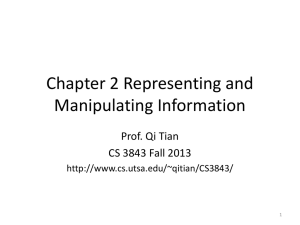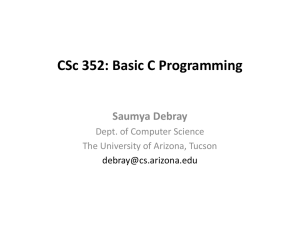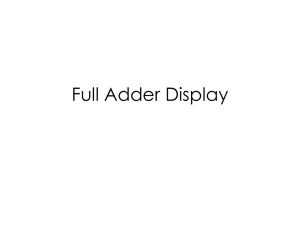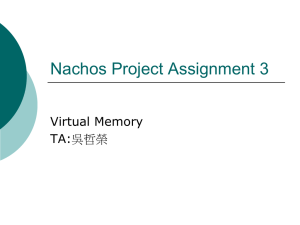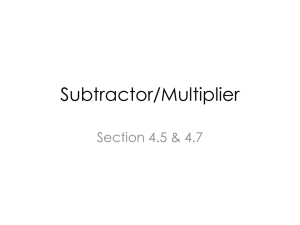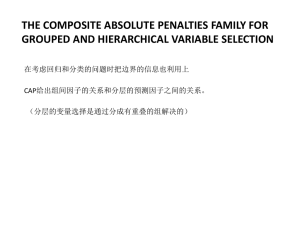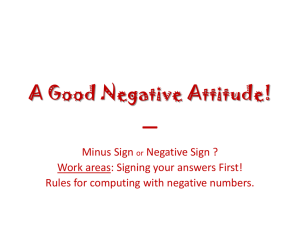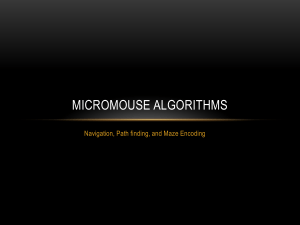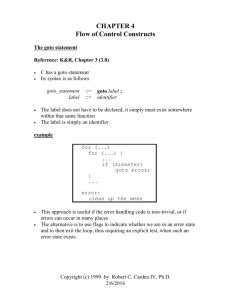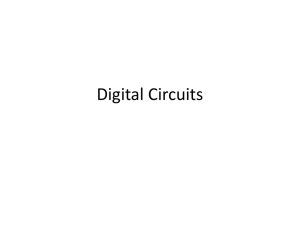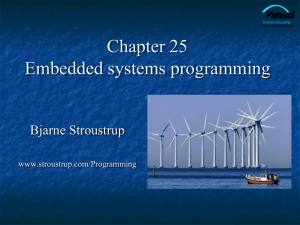Bits, Bytes, Ints
advertisement
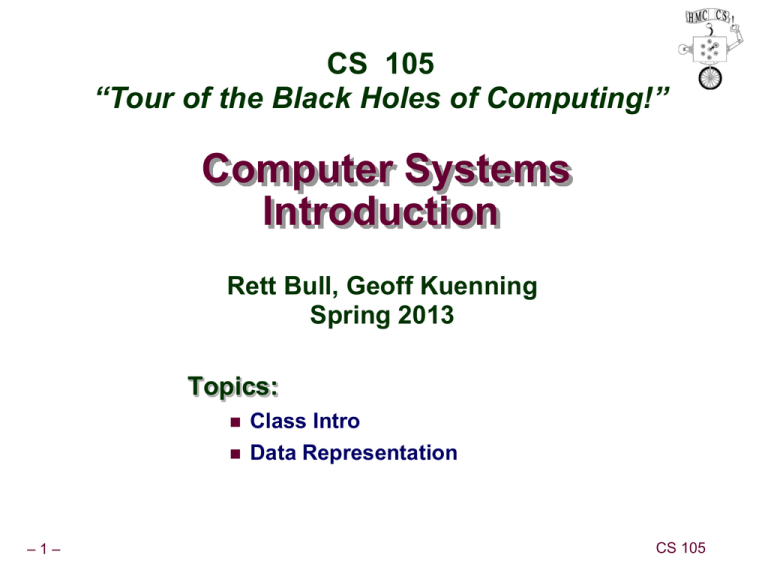
CS 105 “Tour of the Black Holes of Computing!” Computer Systems Introduction Rett Bull, Geoff Kuenning Spring 2013 Topics: –1– Class Intro Data Representation CS 105 Course Theme Abstraction is good, but don’t forget reality! Many CS Courses emphasize abstraction Abstract data types Asymptotic analysis These abstractions have limits Especially in the presence of bugs Need to understand underlying implementations Useful outcomes Become more effective programmers Able to find and eliminate bugs efficiently Able to tune program performance Prepare for later “systems” classes in CS Compilers, Operating Systems, File Systems, Computer Architecture, Robotics, etc. –2– CS 105 Textbooks Randal E. Bryant and David R. O’Hallaron, “Computer Systems: A Programmer’s Perspective”, 2nd Edition, Prentice Hall, 2011. Brian Kernighan and Dennis Ritchie, “The C Programming Language, Second Edition”, Prentice Hall, 1988 Larry Miller and Alex Quilici –3– The Joy of C, Wiley, 1997 CS 105 Syllabus –4– Syllabus on Web: http://www.cs.hmc.edu/~geoff/cs105 Calendar defines due dates Labs: cs105submit for some, others have specific directions CS 105 Notes: Work groups You must work in pairs on all labs Honor-code violation to work without your partner! Corollary: showing up late doesn’t harm only you Handins Check calendar for due dates Electronic submissions only Grading Characteristics Lab scores tend to be high Serious handicap if you don’t hand a lab in Tests & quizzes typically have a wider range of scores I.e., they’re primary determinant of your grade » …but not the ONLY one –5– Do your share of lab work and reading, or bomb tests Do practice problems in book CS 105 Facilities Assignments will use Intel computer systems Not all machines are created alike Even Intel Macs aren’t necessarily compatible Most modern machines (including Knuth) are 64-bit Wilkes: x86/Linux specifically set up for this class Log in on a Mac, then ssh to Wilkes If you want fancy programs, start X11 first Directories are cross-mounted, so you can edit on Knuth or your Mac, and Wilkes will see your files …or ssh into Wilkes from your dorm All programs must run on Wilkes: that’s where we grade –6– CS 105 CS 105 “Tour of the Black Holes of Computing” Integers Topics Numeric Encodings Unsigned & two’s complement Programming Implications C promotion rules Basic operations Addition, negation, multiplication Programming Implications Consequences of overflow Using shifts to perform power-of-2 multiply/divide CS 105 C Puzzles Taken from old exams Assume machine with 32-bit word size, two’s complement integers For each of the following C expressions, either: Argue that it is true for all argument values, or Give example where it is not true • x < 0 ((x*2) < 0) • ux >= 0 Initialization • x & 7 == 7 (x<<30) < 0 int x = foo(); • ux > -1 int y = bar(); • x > y unsigned ux = x; • x * x >= 0 unsigned uy = y; • x > 0 && y > 0 x + y > 0 –8– -x < -y • x >= 0 -x <= 0 • x <= 0 -x >= 0 CS 105 Encoding Integers Unsigned B2U(X ) w1 xi 2 Two’s Complement i B2T (X ) xw1 2 i0 w1 w2 xi 2 i i0 short int x = 15213; short int y = -15213; Sign Bit C short 2 bytes long x y Decimal 15213 -15213 Hex 3B 6D C4 93 Binary 00111011 01101101 11000100 10010011 Sign Bit For 2’s complement, most-significant bit indicates sign 0 for nonnegative 1 for negative –9– CS 105 Encoding Integers (Cont.) x = y = – 10 – Weight 1 2 4 8 16 32 64 128 256 512 1024 2048 4096 8192 16384 -32768 Sum 15213: 00111011 01101101 -15213: 11000100 10010011 15213 1 1 0 0 1 4 1 8 0 0 1 32 1 64 0 0 1 256 1 512 0 0 1 2048 1 4096 1 8192 0 0 0 0 15213 -15213 1 1 1 2 0 0 0 0 1 16 0 0 0 0 1 128 0 0 0 0 1 1024 0 0 0 0 0 0 1 16384 1 -32768 -15213 CS 105 Numeric Ranges Unsigned Values UMin = 0 Two’s-Complement Values TMin = –2w–1 000…0 UMax 100…0 = 2w – 1 111…1 TMax = 2w–1 – 1 011…1 Other Values Minus 1 111…1 Values for W = 16 UMax TMax TMin -1 0 – 11 – Decimal 65535 32767 -32768 -1 0 Hex FF FF 7F FF 80 00 FF FF 00 00 Binary 11111111 11111111 01111111 11111111 10000000 00000000 11111111 11111111 00000000 00000000 CS 105 Values for Different Word Sizes W UMax TMax TMin 8 255 127 -128 16 65,535 32,767 -32,768 32 4,294,967,295 2,147,483,647 -2,147,483,648 Observations |TMin | = C Programming TMax + 1 Asymmetric range UMax = 64 18,446,744,073,709,551,615 9,223,372,036,854,775,807 -9,223,372,036,854,775,808 2 * TMax + 1 #include <limits.h> K&R Appendix B11 Declares constants, e.g., ULONG_MAX LONG_MAX LONG_MIN – 12 – Values platform-specific CS 105 An Important Detail No Self-Identifying Data Looking at a bunch of bits doesn’t tell you what they mean Could be signed, unsigned integer Could be floating-point number Could be part of a string Only the Program (Instructions) Knows for Sure! – 13 – CS 105 Unsigned & Signed Numeric Values X 0000 0001 0010 0011 0100 0101 0110 0111 1000 1001 1010 1011 1100 1101 1110 1111 – 14 – B2U(X) 0 1 2 3 4 5 6 7 8 9 10 11 12 13 14 15 B2T(X) 0 1 2 3 4 5 6 7 –8 –7 –6 –5 –4 –3 –2 –1 Equivalence Same encodings for nonnegative values Uniqueness Every bit pattern represents unique integer value Each representable integer has unique bit encoding CS 105 Casting Signed to Unsigned C Allows Conversions from Signed to Unsigned short int x = 15213; unsigned short int ux = (unsigned short) x; short int y = -15213; unsigned short int uy = (unsigned short) y; Resulting Value No change in bit representation Nonnegative values unchanged ux = 15213 Negative values change into (large) positive values uy = 50323 – 15 – CS 105 Relation Between Signed & Unsigned Weight 1 2 4 8 16 32 64 128 256 512 1024 2048 4096 8192 16384 32768 Sum – 16 – uy = -15213 1 1 1 2 0 0 0 0 1 16 0 0 0 0 1 128 0 0 0 0 1 1024 0 0 0 0 0 0 1 16384 1 -32768 -15213 y + 2 * 32768 = 50323 1 1 1 2 0 0 0 0 1 16 0 0 0 0 1 128 0 0 0 0 1 1024 0 0 0 0 0 0 1 16384 1 32768 50323 y + 65536 CS 105 Signed vs. Unsigned in C Constants By default are considered to be signed integers Unsigned if have “U” as suffix 0U, 4294967259u Casting Explicit casting between signed & unsigned same as U2T and T2U int tx, ty; unsigned ux, uy; tx = (int) ux; uy = (unsigned) ty; Implicit casting also occurs via assignments and procedure calls tx = ux; uy = ty; – 17 – CS 105 Casting Surprises Expression Evaluation If you mix unsigned and signed in single expression, signed values are implicitly cast to unsigned Including comparison operations <, >, ==, <=, >= Examples for W = 32 Constant1 – 18 – Constant2 0 -1 -1 0u 0 0u 2147483647 2147483647u -1 (unsigned) -1 2147483647 2147483647 -2147483648 -2147483648 -2 -2 2147483648u (int) 2147483648u Relation Evaluation CS 105 Casting Surprises Expression Evaluation If you mix unsigned and signed in single expression, signed values are implicitly cast to unsigned Including comparison operations <, >, ==, <=, >= Examples for W = 32 Constant1 – 19 – 0 -1 -1 2147483647 2147483647U 2147483647u -1 (unsigned) -1 2147483647 2147483647 2147483647 2147483647 Constant2 Relation Evaluation 0U 0u 0 0U 0u -2147483648 -2147483648 -2 -2 2147483648U 2147483648u (int) 2147483648U 2147483648u == < > > < > > < > unsigned signed unsigned signed unsigned signed unsigned unsigned CS 105 signed Explanation of Casting Surprises 2’s Comp. Unsigned Ordering Inversion Negative Big Positive TMax 2’s Comp. Range – 20 – 0 –1 –2 TMin UMax UMax – 1 TMax + 1 TMax Unsigned Range 0 CS 105 Sign Extension Task: Given w-bit signed integer x Convert it to w+k-bit integer with same value Rule: Make k copies of sign bit: X = xw–1 ,…, xw–1 , xw–1 , xw–2 ,…, x0 w k copies of MSB X • • • • • • X – 21 – • • • k • • • w CS 105 Sign Extension Example short int x = 15213; int ix = (int) x; short int y = -15213; int iy = (int) y; Decimal Hex 15213 3B 15213 00 00 3B -15213 C4 -15213 FF FF C4 x ix y iy – 22 – 6D 6D 93 93 Binary 00111011 00000000 00000000 00111011 11000100 11111111 11111111 11000100 01101101 01101101 10010011 10010011 Converting from smaller to larger integer data type C automatically performs sign extension CS 105 Why Should I Use Unsigned? Be careful using C compilers on some machines generate less efficient code unsigned i; for (i = 1; i < cnt; i++) a[i] += a[i-1]; Easy to make mistakes for (i = cnt-2; i >= 0; i--) a[i] += a[i+1]; Do use when performing modular arithmetic Multiprecision arithmetic Other esoteric stuff Do use when need extra bit’s worth of range – 23 – Working right up to limit of word size E.g., array sizes CS 105 Negating with Complement & Increment Claim: Following holds for 2’s complement ~x + 1 == -x Complement Observation: ~x + x == 1111…112 == -1 x 1001 1101 + ~x 0110 0010 -1 1111 1111 Increment ~x + x + (-x + 1) ~x + 1 == -1 + (-x + 1) == -x Warning: Be cautious treating int’s as integers – 24 – OK here (associativity holds) CS 105 Comp. & Incr. Examples x = 15213 Decimal x 15213 ~x -15214 ~x+1 -15213 y -15213 Hex 3B 6D C4 92 C4 93 C4 93 Binary 00111011 01101101 11000100 10010010 11000100 10010011 11000100 10010011 0 0 ~0 ~0+1 – 25 – Decimal 0 -1 0 Hex 00 00 FF FF 00 00 Binary 00000000 00000000 11111111 11111111 00000000 00000000 CS 105 Unsigned Addition u • • • v • • • u+v • • • UAddw(u , v) • • • Operands: w bits + True Sum: w+1 bits Discard Carry: w bits Standard Addition Function Ignores carry output Implements Modular Arithmetic s = UAddw(u , v) = u + v mod 2w u v UAddw (u,v) w u v 2 – 26 – u v 2w u v 2w CS 105 Two’s-Complement Addition u • • • v • • • u+v • • • TAddw(u , v) • • • Operands: w bits + True Sum: w+1 bits Discard Carry: w bits TAdd and UAdd have identical bit-level behavior – 27 – Signed vs. unsigned addition in C: int s, t, u, v; s = (int) ((unsigned) u + (unsigned) v); t = u + v Will give s == t CS 105 Detecting 2’s-Comp. Overflow Task 2w–1 Given s = TAddw(u , v) Determine if s = Addw(u , v) Example int s, u, v; s = u + v; PosOver 2w –1 0 Claim Overflow iff either: NegOver u, v < 0, s 0 (NegOver) u, v 0, s < 0 (PosOver) – 28 – CS 105 Multiplication Computing exact product of w-bit numbers x, y Either signed or unsigned Ranges Unsigned: 0 ≤ x * y ≤ (2w – 1) 2 = 22w – 2w+1 + 1 Up to 2w bits Two’s complement min: x * y ≥ (–2w–1)*(2w–1–1) = –22w–2 + 2w–1 Up to 2w–1 bits (including 1 for sign) Two’s complement max: x * y ≤ (–2w–1) 2 = 22w–2 Up to 2w bits, but only for (TMinw)2 Maintaining exact results – 29 – Would need to keep expanding word size with each product computed Done in software by “arbitrary-precision” arithmetic packages CS 105 Power-of-2 Multiply by Shifting Operation u << k gives u * 2k Both signed and unsigned Operands: w bits True Product: w+k bits Discard k bits: w bits Examples u · 2k 2k 0 ••• 0 1 0 ••• 0 0 • • • UMultw(u , 2k) ••• 0 ••• 0 0 0 ••• 0 0 TMultw(u , 2k) u << 3 u << 5 - u << 3 Most machines shift and add much faster than multiply – 30 – * u k • • • == == u * 8 u * 24 Compiler generates this code automatically CS 105 Unsigned Power-of-2 Divide by Shifting Quotient of unsigned by power of 2 u >> k gives u / 2k Uses logical shift k u Operands: Division: Result: x x >> 1 x >> 4 x >> 8 – 31 – / 2k ••• ••• 0 ••• 0 1 0 ••• 0 0 u / 2k 0 ••• ••• u / 2k 0 ••• ••• Division 15213 7606.5 950.8125 59.4257813 Binary Point Computed 15213 7606 950 59 Hex 3B 6D 1D B6 03 B6 00 3B . ••• Binary 00111011 01101101 00011101 10110110 00000011 10110110 00000000 00111011 CS 105
